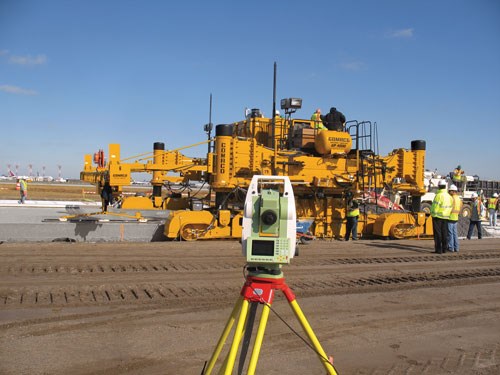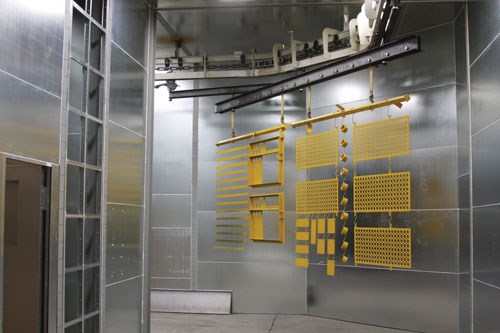With as much steel that passes through the Gomaco Corp. plant in Ida Grove, Iowa, it’s easy to see why the makers of some of the best concrete construction equipment in the world would be concerned about paint adhesion and proper pretreatments.
So when the opportunity came to upgrade the company’s finishing line a few years ago, one of the focuses for Dan Soellner, Gomaco’s general manager of manufacturing, was getting the right cleaning and pretreatment system in place that could help deliver high-quality products, while at the same time offer increased efficiencies.
“We were painting in an older technology with an alkaline paint, and we wanted to move to a 2K system,” says Soellner, referring to a coating system of mixing a finish with a hardener, catalyst or activator. “It’s a much more durable painting system, but making the change was going to present some challenges to us.”
Most notably was that the previous Gomaco paint line came after assembly, so switching to a line where parts were painted before the machines were put together at the factory would bring some handling issues.
Conversion to 2K
Gomaco began planning the conversion to 2K four years ago, looking at moving pretreatment and painting to the front of the assembly line, and at the same time looking at all aspects of the conversion, from chemical baths to switching to an electrostatic paint system.
It wasn’t until about two years ago that the company finally settled on what the new line would look like and how it world work together, and last November it launched the new system.
“We’ve been very pleased with how things have gone for us,” Soellner says. “There have been some cost savings but, more importantly, it’s a more durable finish for us and gives our customers better products.”
Previously, the Gomaco team would shot blast parts for its large curb and gutter machines, pavers, spreaders, and other products, then remove them from the cabinet and set them aside to be primed later. When the parts were finally assembled and ready for paint, the crew would have to tape and plug all the hose openings before applying the topcoat. All that added up to extensive part handling and movement before the parts headed out the door.
“It was an extremely inefficient system,” Soellner says. “It wasn’t feasible to keep doing what we were doing, and we knew our entire manufacturing process would have to change to incorporate a new 2K system.”
Start with In-Line Shot Blast
With the new system, the parts are first run through an in-line shot-blast system before heading to a five-stage washer system that includes an alkaline wash, rinsing, a non-phosphate conversion coating for corrosion resistance, a second rinse and finally, sealing of the parts. They then head to a dry-off oven and a cool-down area before being primed.
It was while designing the five-stage washer system that Gomaco came into contact with
DuBois Chemicals, Surface Finishing’ Al Vanderberg, a 30-year veteran of the cleaning and pretreatment industry whose company had worked with Soellner at Gomaco’s sister plant, Bobalee Hydraulics in Laurens, Iowa. The discussion turned to adding the washer system after Gomaco worked in concert with MIC/Hentzen Coatings to develop a paint specification requirement.
“We ran several test panels simulating our desired pretreatment process to determine if they would meet our specifications,” Soellner says. “After several test runs, it was determined the process we designed would meet or exceed our paint specification requirement.”
Low-Temperature Cleaning
Vanderberg recommended going to DuBois’ Zirconization process, a pretreatment that combines low-temperature cleaning technology, transition-metal formulation and rinse-water-quality maximization to minimize the need for process heat, eliminate the use of phosphates, reduce cleaning system maintenance and improve product quality.
Vanderberg says Zirconization uses DuraTEC phosphate-free chemistry to help promote rapid, tight coating formation on parts, while minimizing sludge creation and flash rusting. Typical use concentration in Zirconization is 1 to 5 percent, similar to conventional iron phosphate, and Vanderberg says some users have had success with concentrations as low as 0.5 percent.
“Bath pH should be maintained between 4 and 5, and adjustments can be made from any common alkaline source such as potassium, sodium or ammonium hydroxide,” Vanderberg says. “The bath will form a coating at ambient temperature, but 90–105°F is most common, due to carry-over heat from the cleaning stage.”
Bruce Dunham, technical and marketing manager for DuBois, says transition group metals such as zirconium have chemical properties similar to chromium, but do not have the environmental and worker safety issues surrounding that metal.
Dunham says fluoro-based acids have been used for aluminum pretreatment for decades, however, using similar chemistries to treat parts produced from steel and other metals have resulted in unstable baths, rusty parts and lower corrosion resistance than iron phosphate.
Improved Transition Metal Treatment
“Improvements in transition metal pretreatment formulations resulted in introduction of several phosphate-free pretreatment formulations into the market,” Dunham says. “The chemicals tended to be corrosive to mild steel washers, and they were relatively sensitive to water-quality variations, which resulted in parts that were susceptible to flash rusting after treatment.”
Vanderberg and Soellner sat down and wrote a process plan for the five-stage wash system to assist the Gomaco team in controlling the operation, a big benefit that Soellner would recommend to anyone adding a new pretreatment system.
“We eventually came up with a control chart for the system, and in doing so we eliminated a lot of potential problems up front for adhesions and other issues that might have come up,” he says.
Dunham says a Zirconization bath actually runs very similar to an iron phosphate bath and can be used in existing washers that use iron phosphate, often with no physical changes to the washer itself.
“It can be used to replace a four-stage-or-more phosphate system, and can be used in either spray or soak systems,” Dunham says. “The parts will need a cleaning stage prior to Zirconization, and a clean part is essential for it to work. Also, the parts will need to be rinsed following Zirconization. For three-stage systems, DuBois has chemistry that combines cleaning and Zirconization in one product. ”
Four-Stage System
According to Vanderberg, the minimum washer requirement would be a four-stage system: clean, rinse, Zirconization, rinse. He says a typical five-stage system would include these four steps, followed by a final rinse or seal.
Using the new “paint before assemble” system, the Gomaco power and free paint line moves the parts from the dry-off area and then to the primer booth for a yellow primer coating before they are sent to a flash tunnel. After the parts make their way through the topcoat booth, they go through another flash tunnel before heading to a curing oven, then a cool-down area and then on to assembly.
Gomaco installed a Graco 2K paint system, which can accommodate up to six paint colors. Currently, the company is using only four colors: flat black, gloss black, white and yellow.
“The system is set up that we could add powder coating in the future if we wanted to do that,” Soellner says. “Right now, we don’t see the powder temperature technology conducive to allow us flexibility for the substrate thicknesses.”
Gomaco has already seen more cost savings on gas consumption and electricity then what was initially planned. All motors for the wash system and other electrical motors were set up on variable frequency drives to reduce electrical consumption. Gas savings are due to ideal length of flash tunnels and the ability to reduce oven temperatures.
“Systems of these types take a great deal of planning and organizing to put into place,” Soellner says. “We wanted a system that would give us a superior final painted product. That’s what we have accomplished: a corrosion-resistant finish through green technology and ecological consideration, and an appealing product that should give our customers several years of service with world-class 2K paint quality.” n














.jpg;maxWidth=300;quality=90)








